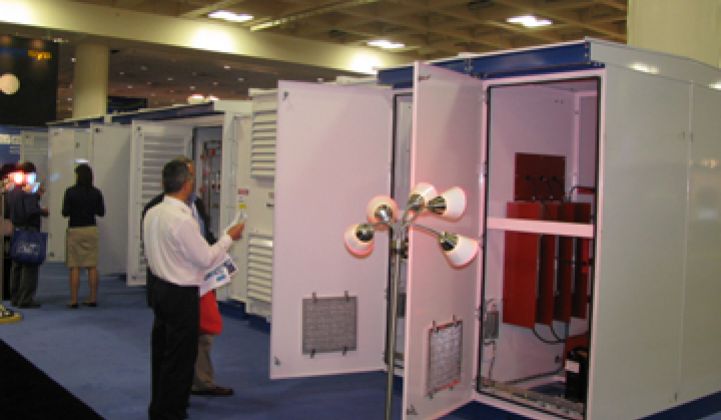American Electric Technologies got its first solar inverter certified for sale in the U.S. last week.
Not bad for a company founded in 1946.
The publicly traded company has provided converters, inverters and power equipment to run the DC-based equipment employed by the oil and gas industry for decades. Now, with the growth in solar, it has fashioned a utility-scale inverter for multi-megawatt projects. The first product -- the one that just got certified -- is a 1,000-volt, 1-megawatt inverter for solar fields. (Technically, it can go to 1200 volts, but everyone wants a margin.) While 1000-volt inverters can be obtained in Germany, U.S. utility fields largely rely on 600-volt inverters. (See photo.)
"We are used to 1.5-megawatt distributed generation projects: foot throttles, mud pumps," said CEO Charles Dauber during an impromptu meeting on the floor at Intersolar, which is taking place in San Francisco this week. "Our equipment is in the Middle East, the jungles of South America."
Overall, AmEl has installed over 1 gigawatt worth of equipment in its history.
A 1,000-volt inverter is in many ways a fundamentally different beast, Dauber argued. One just can't scale up smaller inverters. Engineers have to reconsider the selection and arrangement of components and other issues. AmEl, for instance, designs the workstations for technicians in a such a way as to allow them to wear the least amount of protective clothing. Large customers also often want a certain degree of customization.
Although a 1,000-volt inverter costs more than a 600-volt one, it pays dividends immediately. The larger inverters reduce ongoing maintenance, drive down component costs and even increase power production by 10 percent to 15 percent.
"For every dollar you spend, we will give you more watts," he said.
AmEl has yet to land any solar deals, but it just got certified, too. The equipment potentially could go into hundreds of projects.
Elsewhere at the show:
--Battery arrays, while pricey, will get paired with residential solar systems. Companies like Sanyo and Sunverge have already begun to prepare combo packages. Developments in the battery world could soon start making this more affordable. Some researchers have begun to look at lithium-ion batteries specially designed for residential solar systems, according to Matthias Vetter, head of group PV off-grid solutions at the Fraunhofer Institute. Unlike batteries for cars, residential lithium ion batteries don't need tremendous energy density. Homeowners won't drive their homes to Lake Tahoe; the batteries might only be required a few hours a day.
Instead, they will be designed for longevity, able to endure 7,000 charging cycles or 7,300 with grid services versus 6,000 for an ordinary lithium-ion battery or 1,500 for lead acid. These batteries would also have a somewhat low voltage (1.8 volts), a long life and exceptional welding for safety. (For an interesting welding concept, check out ElectronVault.)
Vetter noted that German homes in some regions could get 70 percent of their power from battery/solar systems. He also added that electricity in Germany will cost 38 Euro cents per kilowatt-hour by 2020, adding further impetus to the trend.
--Corning will open a factory next year in Kentucky to mass produce thin, textured glass for solar modules. "Textured glass scatters the light so photons spend a significant amount of time in the semiconductor layer," said John Duke, vice president of PV glass technologies at Corning. Corning's glass was used on General Electric's record-setting cadmium telluride module, a record-setting CdTe cell produced at NREL, and a record-setting tandem-junction amorphous silicon cell produced on Oerlikon equipment. Soon, a record-setting CIGS cell with Corning's glass could be announced.
--The two most discussed concepts at the show: inverters and concentrating photovoltaics. Expect to see some significant announcements about CPV funding soon.
--Two new types of solar modules that may come to market someday: cuprous oxide and tin sulfide. Research is underway on both, says MIT professor Tonio Buonassisi.



